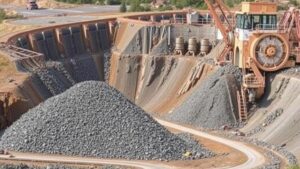The Role of River Systems in Agricola’s Hydraulic Mining Techniques
The Role of River Systems in Agricola’s Hydraulic Mining Techniques
Hydraulic mining, a technique prevalent during the 19th century in California and other parts of the world, is a method that utilizes water to extract gold from riverbeds and gravel deposits. At the heart of this process lies the intricate interplay between river systems and the implementation of these innovative mining techniques. This article delves into the significance of river systems in Agricolas hydraulic mining methodologies, illuminating their critical role in the extraction process.
Understanding Hydraulic Mining
Hydraulic mining involves directing high-pressure streams of water onto soil and rock, thereby dislodging valuable minerals. Agricola, a pioneering figure in mining theory, laid the groundwork for various mining techniques, including hydraulic mining, in his seminal work De Re Metallica. His principles not only emphasized the importance of water but also underscored the necessity of river systems for efficient hydraulics.
The Dependency on River Systems
River systems serve as an invaluable source of water necessary for hydraulic mining operations. The process requires consistent and ample water flow, typically derived from nearby rivers. Key reasons for this dependency include:
- Water Volume: Sufficient water volume is essential to generate pressure and effectively wash away sediment.
- Logistical Access: River systems often provided the necessary access to remote areas where gold deposits were abundant.
- Hydrological Balance: Properly managing water resources ensured stable operations, minimizing the impact on local ecosystems.
Case Study: The Gold Rush Era
During the California Gold Rush, which began in 1848, hydraulic mining reached its zenith. Miners relied heavily on the Sierra Nevada mountain rivers, which provided the essential water flow needed for mining operations. The successful use of hydraulic mining in this era demonstrates the profound connection between river systems and mining techniques.
For example, the rivers such as the American River were harnessed to create long toms–a device that allowed miners to efficiently separate gold from other materials. This is an example of how river systems were integrated into the mining apparatus to enhance efficiency and output.
Environmental and Ecological Consequences
While hydraulic mining significantly boosted gold extraction, it also had detrimental effects on river systems and ecosystems. high-pressure water jets eroded riverbanks and altered watercourses, leading to:
- Siltation: Increased sediment in rivers, impacting aquatic life.
- Habitat Destruction: Alterations in water flow disrupted local ecosystems.
- Contamination: Chemicals used in the mining process polluted waterways, affecting both wildlife and human populations.
These ecological consequences highlight the need for sustainable mining practices in the context of river systems, balancing economic interests with environmental stewardship.
Modern-Day Implications and Lessons
The relationship between river systems and hydraulic mining has evolved but remains relevant in contemporary mining practices. Modern hydraulic mining techniques are more controlled and often utilize technology to mitigate environmental impact. Also, understanding the intricate relationship between water systems and mining can inform current water resource management strategies.
Plus, the lessons learned from historical practices can guide future hydraulic projects, ensuring a more sustainable approach that prioritizes ecological balance alongside economic gain.
Conclusion
The role of river systems in Agricola’s hydraulic mining techniques is a profound example of how natural resources can be harnessed for economic benefit while also necessitating a conscious effort to mitigate environmental impact. By studying the intricate dynamics of this relationship, historians and environmental scientists can gain valuable insights into sustainable practices that honor both resource extraction and ecological preservation.
In essence, river systems are not merely conduits of water but essential components of geological extraction processes that require thoughtful management and innovative solutions for the future.

